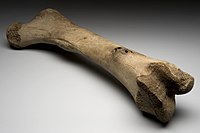
Photo from wikipedia
Pathological destructive bone diseases are primarily caused by the failure of a lifelong self‐renewal process of the skeletal system called bone remodelling. The mechanisms underlying this process include enhanced osteoclast… Click to show full abstract
Pathological destructive bone diseases are primarily caused by the failure of a lifelong self‐renewal process of the skeletal system called bone remodelling. The mechanisms underlying this process include enhanced osteoclast activity and decreased generation of the osteoblast lineage. Intercellular interaction and crosstalk among these cell types are crucial for the maintenance of bone remodelling, either through the secretion of growth factors or direct cell–cell physical engagement. Recent studies have revealed that exosomes derived from bone cells, including osteoclasts, osteoblasts and their precursors, play pivotal roles on bone remodelling by transferring biologically active molecules to target cells, especially in the processes of osteoclast and osteoblast differentiation. Here, we review the contents of bone‐derived exosomes and their functions in the regulatory processes of differentiation and communication of osteoclasts and osteoblasts. In addition, we highlight the characteristics of microRNAs of bone‐derived exosomes involved in the regulation of bone remodelling, as well as the potential clinical applications of bone‐derived exosomes in bone remodelling disorders.
Journal Title: Journal of Cellular and Molecular Medicine
Year Published: 2017
Link to full text (if available)
Share on Social Media: Sign Up to like & get
recommendations!